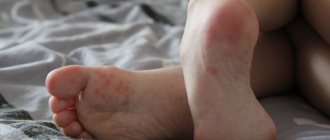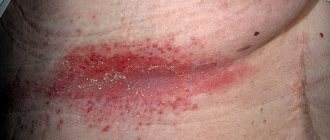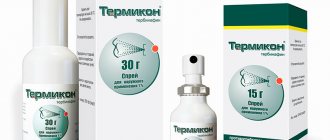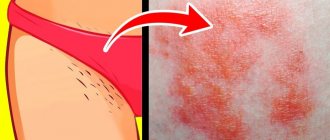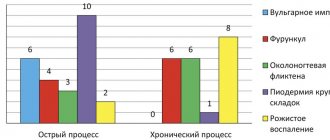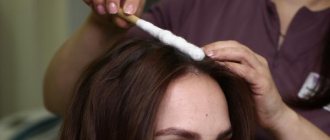345
230
Diaper rash in newborns (diaper dermatitis) is a problem that almost every mother faces. Irritation usually appears in the folds of the baby’s skin (cervical, popliteal, inguinal, elbow, axillary), sometimes you may notice diaper rash on the baby’s bottom.
Most often, irritation occurs in children from 1 month to a year. According to statistics, diaper dermatitis of varying degrees occurs in 50% of children under 2 years of age (USA - 75%, Japan - 87%). It is important to detect redness in time and exclude possible complications.
Causes of diaper rash in newborns
The main reason why newborn babies are most susceptible to diaper rash is the structure of their skin. The lipid barrier on its surface is still very thin and sensitive to any aggressive external influences, and the stratum corneum is 30% thinner than that of an adult.
As a result, the protective properties of the skin can be destroyed due to temperature changes, frequent bathing, and the use of hygiene products that are not intended for children's skin.
Rash with redness
Disseminated granuloma annulare due to diabetes
In addition to itching, the rash may also be accompanied by redness (dark red to brownish-red). A burning sensation, pain, lumpiness, and clear or yellow discharge may be present. These symptoms may spread to other parts of the body, such as the buttocks or groin.
Some of the most common causes include shaving, fungal infection, candidiasis, folliculitis, HIV, use of certain deodorants, contact dermatitis, disseminated granuloma annulare, lymphoma, cellulitis, lichen, eczema, urticaria and others.
Diaper rash usually occurs as a result of:
- excessive sweating. Due to the fact that some mothers are afraid of colds and hypothermia, they wrap their babies like cabbage. As a result, the child’s skin does not breathe at all, and sweat appears in its folds, which leads to inflammation.
- untimely hygiene. Newborns defecate very often. Uric acid itself causes irritation, and when combined with feces it forms ammonia, which can damage the skin many times more.
- mechanical impact. This could be a diaper that is not put on correctly, clothes made of synthetic fabrics or with tight seams, or uncomfortable underwear.
- high humidity. Most often, this situation occurs when the baby is not wiped dry after bathing. Water remains in the folds of the skin and causes irritation. Diaper rash on the neck of a baby often appears for this very reason.
- allergies. Usually it comes in 2 types: food. If the baby is breastfed, then allergies can be caused by changes in the mother's diet. In addition, skin irritation is often provoked by foods that the baby first tries when complementary feeding begins.
- contact This may be a reaction to the chemical composition of washing powder, hygiene products or diapers.
Preventive recommendations
In order not to face the problem of irritation, you need to remember why it can happen. This will help prevent unpleasant itching and discomfort. Preventive recommendations are as follows:
You should not wear clothes that fit closely to the skin. You should not wear synthetic fabrics, give preference to natural clothes. It is necessary to wash twice a day, as pathogenic bacteria develop in sweat.
When removing unwanted hair, you must act in accordance with the recommendations for the procedure (moisturize the skin and use special shaving products, completely dry the skin before waxing, etc.).
Do not apply deodorant immediately after shaving. After showering, let your skin dry completely before applying antiperspirant. In case of skin injuries, you need to treat the damage with an antiseptic. It is better to trim long hair before shaving.
Source: ogidroze.ru
What are the degrees of diaper rash?
Doctors distinguish 3 degrees of diaper dermatitis:
- 1st degree.
The mildest stage, in which only slight redness or rash is noticeable. There are no lesions on the skin, and the baby does not show any signs of anxiety. - 2nd degree.
The redness becomes brighter, in addition to them microcracks and small pustules appear. The child tries to reach out with his hands to damaged areas of the skin, is capricious, and cries when you change a diaper or clothes. - 3rd degree.
The redness is very intense, the area of diaper rash is covered with ulcers and ulcers, and liquid is released from cracks in the skin. The baby constantly cries and becomes overly restless, as the pain prevents him from sleeping, eating, and staying awake.
If parents cope with mild diaper rash on their own, then if more serious symptoms appear, you should immediately contact your pediatrician. Only he will be able to accurately make a diagnosis, determine the degree of development of the disease and tell you how to treat diaper rash in newborns. Please never act as a doctor yourself, otherwise you may face complications and unnecessary side effects.
Clinical manifestations
It is easy to recognize diaper rash in the armpits by typical symptoms:
- The occurrence of skin hyperemia, swelling and discomfort.
- Itching and burning.
- The appearance of minor injuries on the surface of the skin, erosions or ulcers in advanced forms of the disease.
- The appearance of a pustular rash caused by the addition of secondary microflora.
In the case of infection of damaged skin, the rashes are characterized by polymorphism: papular formations containing pus inside, dense nodules, and blisters with transparent contents can be detected.
Clinically, the course of intertriginous dermatitis can be divided into three successive stages:
- There is only moderate redness of the skin, discomfort in the armpit area, mild itching and pain. There are no visible cracks or abrasions.
- The second stage is characterized by the appearance of painful cracks, abrasions, pain, severe redness of the skin, and the appearance of rashes of various appearances.
- A distinctive feature of the third stage is deep and pronounced damage to the skin. Erosion and ulcerative bleeding defects appear. The third stage is characterized not only by local symptoms, but also by fever, deterioration in general health, and signs of intoxication.
Treatment of diaper rash in the early stages is not particularly difficult. At the same time, advanced forms of the disease require long-term and persistent therapy.
Diaper rash care
How to treat diaper rash in newborns? Doctors recommend purchasing special products that will help soothe the skin and relieve irritation. The product must be safe for children's skin, without fragrances or dyes. Typically, special creams are applied several times a day until the redness completely disappears.
If you notice slight redness on your baby's skin, it is important to review his skin care and make the necessary adjustments. Usually it is enough to be more attentive during daily hygiene, change diapers in a timely manner, and make sure that the child does not overheat.
During this period, it is especially important to pay attention to the fact that skin care products are hypoallergenic, do not contain harmful additives, and are approved by pediatricians.
Anti-inflammatory powder “My Sunshine®” is included in this category. It will help prevent and eliminate irritation, redness and diaper rash. The composition includes zinc oxide, which perfectly dries out inflammation. Powder-cream “My Sunshine®” differs from regular powder in that it does not roll off on the skin and provides more comfortable and safe use. It prevents powdered talc from entering the baby's respiratory tract. You just need to apply powder-cream for diaper rash in newborns on the baby’s skin in places of redness and watch how they gradually disappear.
Also pay attention to the cream with panthenol “My Sunshine®”. It contains 5% D-panthenol, a concentration considered optimal in clinical studies. Cream Children's panthenol “My Sunshine®” promotes:
- restoration of healthy baby skin;
- improving the protective functions of the epidermis;
- protecting children's skin from moisture loss.
The cream is suitable both for getting rid of diaper rash and for preventing its occurrence.
Both products from the “Moyo Solnyshko®” brand can be used for babies from the moment of birth.
If you experience grade 2 or 3 diaper rash, you should visit your doctor. He will conduct the necessary tests and make an accurate diagnosis. In this case, all you have to do is follow his recommendations, follow the instructions in a timely manner and monitor the progress of treatment.
General principles of treatment
In order to effectively combat diaper rash in the armpits in adults, treatment should be carried out taking into account the following factors:
- The immediate cause that causes the appearance of intertriginous dermatitis. Measures are being taken to reduce weight, normalize metabolic processes, correct blood glucose levels, and eliminate the allergic component.
- Stages of the process. If the initial manifestations of the disease are quite easy to cope with on your own at home, then the appearance of weeping ulcers and extensive erosions, as well as signs of a secondary microbial or fungal infection, requires immediate medical intervention.
Treatment for diaper rash in the armpits includes:
- Compliance with sanitary and hygienic standards. It is recommended to take a warm shower at least twice during the day. As a hygiene product, it is better to use baby or laundry soap, avoiding the use of moisturizing cosmetics. The skin of the axillary areas should be wiped dry, carefully applying a towel to avoid additional injury. Clothing should only be worn on dry skin.
- Refusal to use any antiperspirants and alcohol-containing cosmetics for the period of treatment.
- Local use of medications that have a drying effect and do not cause additional irritation. In the initial stages of the disease, both traditional medicine and ointments, which can be purchased at pharmacies, can be effective.
- Prescribing antibacterial therapy and antifungal drugs in the event of a secondary infection.
Antimicrobial drugs are prescribed by the doctor after examining the patient and conducting the necessary examinations.
Self-medication in such a situation is fraught with the development of unwanted side reactions and complications.
Traditional medicine
Decoctions, lotions, and infusions made from dry plant materials are used. To treat damaged skin, it is recommended to use:
- Oak bark. Has a drying, anti-inflammatory effect. In the early stages, it helps to quickly cope with skin redness, eliminates itching, and promotes healing.
- Chamomile flowers. A decoction of this plant effectively fights inflammation and has deodorizing and wound-healing properties.
- A series. The prepared decoction has astringent, healing, anti-inflammatory and antiallergic properties. Relieves severe itching and relieves pain.
- Eucalyptus. A decoction of the leaves of the plant has a mild soothing effect, deodorizes the skin, reduces sweat, and has wound healing and anti-inflammatory effects.
Calendula, yarrow, and sage also have a good therapeutic effect.
If diaper rash occurs, it is necessary to treat the skin in the armpits with decoctions of medicinal herbs at least twice a day, and if possible, more often.
Medications
Among the topical preparations that have a drying, antiseptic and healing effect, which are recommended for use in the early stages of development of diaper rash in the armpits, the following can be mentioned:
- Solutions with an antiseptic and drying effect. Most often they are used before using an ointment medicine. A 10% solution of boric acid on glycerin, miramistin, chlorhexidine is recommended.
- Ointments with a pronounced drying effect - zinc, Teymurov paste, Lassara, Desitin cream, powder containing xeroform. Apply at least twice a day to dry skin, pre-treated with an antiseptic solution.
- Ointments that promote wound healing and tissue regeneration, reducing inflammatory tissue infiltration - Dexpanthenol, Bepanten, Panthenol cream.
Physiotherapeutic procedures, in particular, ultraviolet irradiation of damaged skin, especially when weeping, difficult-to-heal erosions occur against the background of severe metabolic disorders, also provide a good therapeutic effect. Treatment of stage 2 and 3 diaper rash requires the prescription of antibacterial and antifungal drugs, not only local, but also systemic. That is why it must be carried out under medical supervision.
Diaper rash occurs not only in infants, but also in adults. This unpleasant disease affects areas of the skin that are in constant friction. One of these areas is the area under the arms. Dermatology calls this inflammatory process intertriginous dermatitis. Below we will tell you how to deal with such a nuisance and consider the most effective treatment methods.
Painful rashes
To give you a visual idea of what an armpit rash may look like, here are a few images below. But it may look slightly different, depending on factors such as color, skin sensitivity, etc.
Shingles
Candidiasis – yeast fungal infection
Rash after exposure to poison ivy
Hidradenitis suppurativa – purulent inflammation in the sweat glands
The pain can be dull, sharp or sharp, and the rash can be red, itchy, bumpy, etc. Hidradenitis suppurativa, staphylococcal infection, lichen, cellulitis, urticaria, eczema, folliculitis, some allergic reactions and other diseases can provoke pain rashes in the armpit area.
You can try various home remedies for relief. In addition, various creams or medications can help cope with painful sensations. You should consult your doctor for treatment recommendations.
Symptoms and signs
The appearance of irritation in the armpit area cannot be confused with another pathology, since it exhibits a number of characteristic symptoms, depending on the factor causing them. So:
- With the development of mycoses or candidiasis, irritation is accompanied by a powdery coating with rashes on it of the same pale color,
- With dermatitis, the skin becomes covered with scales, patients feel severe itching,
- Irritation from hyperhidrosis is characterized by severe swelling, redness and burning,
- When reacting to the application of deodorant, redness of the skin is accompanied by a strong burning sensation.
There may be other signs of irritation, often increased sweating begins, and the smell of sweat becomes unusual and unpleasant. Often, the use of even the most persistent deodorants does not prevent the obsessive odor, and frequent washing with antiseptics or soap and water eliminates the odor only for a short time.
Folk remedies and recipes
As folk methods for treating skin irritation, decoctions of medicinal plants can be quite effective. St. John's wort, oak, sage, chamomile, calendula, mint and oregano are commonly used in this capacity. Using procedures in the form of lotions or rubbing with decoctions, you can remove redness of the skin and avoid irritation.
The reasons for the appearance of red spots can be different, each of them requires an individual approach when choosing a treatment method. With the appearance of such symptoms, folk remedies that use medicinal plants and products available in every home in their recipes are quite effectively dealt with.
If the cause of skin changes is a fungus, then traditional medicine suggests using plants with antifungal properties in the form of eucalyptus, mustard, fir and celandine to eliminate it.
A mixture of poplar and birch buds infused with alcohol is no less effective in reducing the activity of the fungus. The kidneys are crushed in equal quantities and infused in good vodka or alcohol. Before treating the skin, alcohol is diluted with water.
The fungus responds well to treatment with tar; for this purpose, pharmaceutical purified tar and tar soap are used.
Fungal diseases are treated with garlic or radish compresses, however, this remedy should be applied carefully to skin with weeping rashes.
Decoctions of chamomile, lingonberry leaf, and St. John's wort herb help well by relieving the symptoms of itching and eliminating inflammatory processes - they are brewed and drunk as tea.
